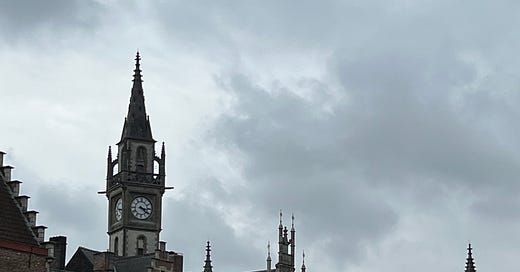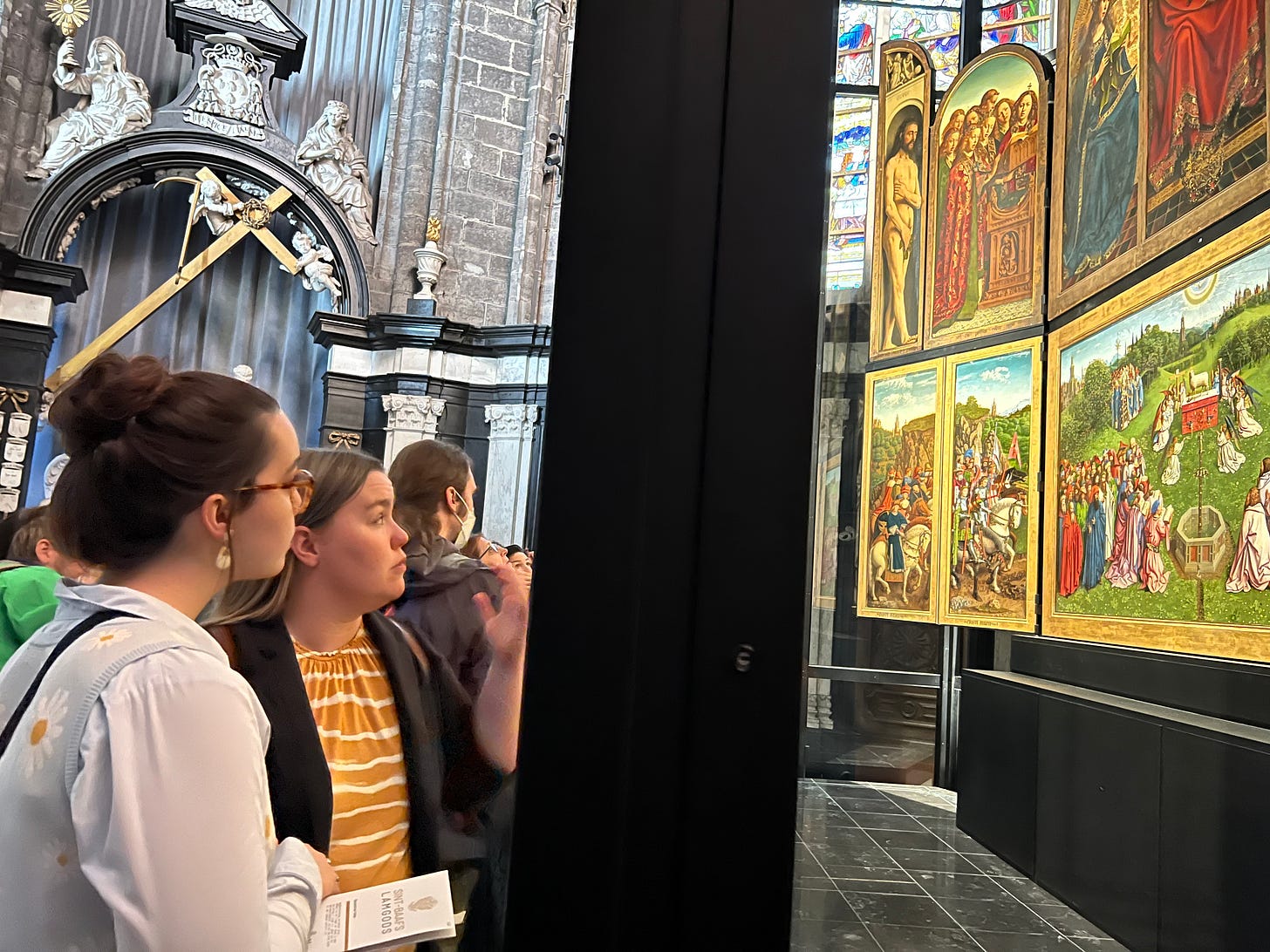All photos, ©, Gail Schroeder, Ghent, Belgium.
This October, we here at City of Ladies took our first retreat together to Belgium. The main attraction of our visit was the Ghent Altarpiece, by Hubert and Jan Van Eyck, in St. Bavo’s Cathedral.
Traveling is a family hobby and the drone of planes and trains lies in the background of many of our favorite memories. We are lovers of art and we are lovers of the pilgrimage one must take to get there.
Ghent is a city where young people live next to old things. Walk past one street of couture shopping and you reach a canal with old granaries converted to restaurants with medieval facades. Walk its streets and you hear a symphony of languages, joined only by common appreciation for a good cup of hot chocolate.
We celebrated Mass in the cathedral before visiting the altarpiece, so the building felt like an old friend by the time we got in line. A little old woman stood guard at the entrance, asking everyone if they spoke French, German, or English - all of which she spoke, of course. Once inside, it’s one quick flight of steps and you’re in the back chapel, where the altarpiece resides.
The altarpiece’s name is The Adoration of the Mystic Lamb.
Photo ©, Gail Schroeder
In the bottom panel, the Lamb of God stands on an altar surrounded by angels. In the surrounding panels, we see various groups close in on the celebration: martyrs, prophets, pagan writers, just judges, knights. As the Magi of old brought gifts to an infant God, these figures have brought their gifts - voices raised in song and prayerful attention.
As All Saints’ Day approaches, I’m reminded how true this is. That everywhere around me, there is an invisible world of worship happening during every minute, a cloud of men and women whose hearts lean toward God. It is the purpose of the altarpiece to open my eyes and see what cannot be seen, but can still be known.
Walking down the grocery store aisles of candy this weekend, I’m reminded how far we’ve come from the true meaning of All Saints’ Day in the celebration of Halloween. Spirit Halloween costumes and trick-or-treating don’t have much to do with the eternal community of worshippers.
But I think the great mystery and beauty of the altarpiece is that in visiting it, we too have gathered, pointed toward the great invisible. My mother, sisters, and I have joined the women in the top right corner, bringing their gifts and talents and prayers in mystical adoration.
Photo, ©, Gail Schroeder
Maybe that’s part of why human beings need art. Art is something visible, tangible, a window pointing us to the invisible reality of which we are a part.
*************************
Photo, ©, Gail Schroeder
Going to Belgium was a once-in-a-lifetime, windfall opportunity, so we ladies jumped at the chance to go. It was an amazing thing to stand before a work of art, just as the artists had once done, and imagine the brothers making their brushes and mixing their paints, and to sense the excitement of their ideas coming to life on the panels. And we are moved to know that this is a piece of art that has been affecting people for almost 600 years.
Interesting things to know about the Ghent Altarpiece:
The painting of the Adoration of the Mystic Lamb was finished and installed in 1432, and is considered by many to be the first major oil painting in history. It is believed to have been begun by Hubert Van Eyck, and after his death, completed by his younger brother, Jan. Although disputed, the Van Eyck brothers are credited with being the first in the West to use oil paint as a medium. In any case, it became widely used after the Van Eyck brothers showed what could be done with oil.
Restoration work begun in 2012 revealed that the face of the Lamb had been painted over in the 16th century, apparently to make the lamb look more like an actual animal. The original version of the Lamb’s face, however, is more human-like, with a penetrating gaze, and has been restored.
Two panels were stolen in 1934, one of which was returned. The one that has never been returned is from the bottom left depicting the Just Judges. There is a reproduction in its place now.
The Ghent altarpiece has been stolen at least twelve times, including by both Napoleon and Hitler, and after WWI the Treaty of Versailles ruled the panels must be returned to Belgium after the Germans had stolen them. The artwork features prominently in the movie The Monuments Men.
The altarpiece is highly symbolic but also has many inscriptions. The words of the Angel Gabriel are shown on the panel as if coming out of his mouth. Mary’s words in reply are also written on the panel shown coming out of her mouth only this time the words are upside down. It is presumed this is to show that Mary is speak to God who is looking down from heaven.
There are many places to find out more about the Ghent Altarpiece. You can start here and here.







